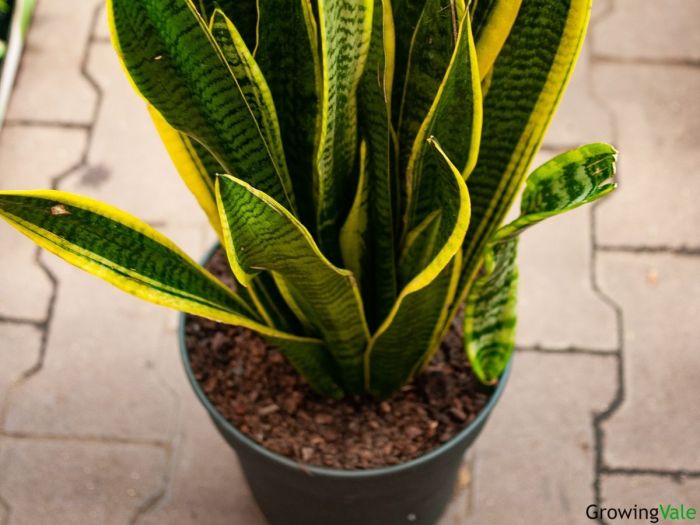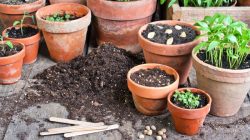Ideal Soil Composition for Snake Plants

Snake plant potting soil – So you wanna give your snake plant the VIP treatment? Forget that sad, soggy soil – we’re talking about creating the ultimate potting paradise for these low-maintenance superstars. The key is a mix that’s as sassy as your snake plant is stylish.
Think of it like this: your snake plant’s roots are total divas. They demand excellent drainage and airflow, refusing to tolerate soggy conditions. Too much moisture leads to root rot, a total party foul for any plant parent. The perfect soil blend is a carefully orchestrated balance of ingredients, each playing a crucial role in keeping your plant happy and thriving.
Let’s break it down.
Optimal Soil Ingredient Balance for Snake Plants
The magic formula? It’s all about achieving the perfect balance of drainage and moisture retention. A well-draining potting mix is essential, and a typical recipe might look something like this: A blend of 2 parts high-quality potting mix (like a cactus and succulent blend), 1 part perlite, and 1 part coarse vermiculite. This combination provides the aeration and drainage that snake plants crave, while still offering enough moisture retention to keep them from completely drying out.
Giving your snake plant the perfect potting soil is key to its thriving. The right blend ensures proper drainage and aeration, crucial for this low-maintenance beauty. To showcase your happy, healthy snake plant, why not find the ideal pot? Check out this amazing selection of pot plant pots for sale to complete the look. Remember, the right pot, combined with the perfect soil, will make your snake plant truly shine!
You could also add a small amount of peat moss for added moisture retention, but don’t go overboard – remember, drainage is king!
Importance of Good Drainage in Snake Plant Potting Soil
Good drainage isn’t just a suggestion; it’s a non-negotiable demand for your snake plant. Imagine your plant’s roots as A-list celebrities attending a swanky Hollywood party. They need plenty of breathing room, and they definitely don’t want to be stuck in a swamp. Poor drainage leads to waterlogging, creating a breeding ground for fungal diseases and ultimately causing root rot.
That’s a total disaster that can kill your plant faster than a bad reality TV show.
Amendments that dramatically improve drainage include perlite (volcanic glass that adds air pockets), pumice (another porous volcanic rock), and coarse sand (avoid fine sand, which can compact). These ingredients act like tiny air conditioners for your plant’s roots, ensuring they get the oxygen they need.
Consequences of Using Soil with Poor Drainage for Snake Plants, Snake plant potting soil
Let’s be real, using the wrong soil is a recipe for disaster. Think of it like trying to wear stilettos to a mud wrestling match – it’s just not gonna work. Poorly draining soil leads to a whole host of problems, including:
- Root Rot: The most common and serious consequence. Waterlogged roots become susceptible to fungal infections, leading to decay and ultimately, plant death. Think of it like a celebrity meltdown – it’s ugly and nobody wants to see it.
- Yellowing Leaves: A telltale sign of overwatering and poor drainage. The leaves turn yellow as the roots struggle to absorb nutrients due to the lack of oxygen.
- Stunted Growth: A plant struggling with root rot and waterlogged soil will simply stop growing. It’s like hitting a creative block – nothing is moving forward.
- Overall Plant Decline: A combination of all the above eventually leads to a weak, unhealthy, and possibly dead plant. It’s like a box office bomb – a total failure.
Comparison of Commercially Available Potting Mixes for Snake Plants
Choosing the right pre-made potting mix can save you some DIY time. However, always check the ingredients to ensure it’s suitable for your snake plant’s needs. Here’s a comparison of a few popular options (note that prices and ingredient specifics can vary by retailer and region):
| Brand | Ingredients | Drainage Properties | Price Range |
|---|---|---|---|
| FoxFarm Ocean Forest Potting Soil | Potting soil, compost, peat moss, vermiculite | Good, but may need amendment for optimal snake plant drainage | $$ |
| Miracle-Gro Cactus, Palm, & Citrus Potting Mix | Potting mix, perlite | Good to excellent | $ |
| Bonsai Jack Cactus & Succulent Mix | Potting mix, perlite, pumice | Excellent | $$$ |
DIY Snake Plant Potting Mix Recipes

Yo, plant peeps! Ready to unleash your inner horticultural hero and whip up some killer potting mixes for your snake plants? Forget those boring pre-made blends – we’re going DIY, and it’s gonna be epic. We’re talking custom-crafted soil that’ll have your snake plants thriving like they’re on a tropical vacation.
Drainage Focused Mix: The “Super Drain” Recipe
This mix is all about letting that waterflow*, preventing soggy roots, and keeping your snake plant happy as a clam. Overwatering is a major snake plant villain, so this recipe is your secret weapon against root rot.
- 2 parts perlite: This volcanic glass is like the ultimate drainage champion. It adds tons of air pockets to the soil, letting water drain like a boss.
- 1 part coco coir: This adds some moisture retention, preventing your soil from drying out completely between waterings. It’s like the Goldilocks of soil amendments – not too dry, not too wet.
- 1 part orchid bark: This adds even more drainage and aeration, keeping things light and airy.
To mix it up, simply combine all ingredients in a large container. Mix thoroughly until evenly distributed. It’s that easy!Pros: Excellent drainage, minimizes risk of root rot.Cons: May dry out quickly, requiring more frequent watering.
Nutrient Retention Focused Mix: The “Nutrient Ninja” Recipe
This mix is for snake plant owners who want to give their plants a nutritional boost. It’s all about holding onto those essential nutrients, ensuring your plant has everything it needs to grow strong and look fabulous.
- 1 part potting soil: Provides a base of essential nutrients and organic matter.
- 1 part coco coir: Excellent at retaining moisture and nutrients.
- 1/2 part perlite: Adds some drainage to prevent overly soggy conditions.
- 1/2 part vermiculite: This adds extra moisture retention and provides some nutrients.
Mix all ingredients thoroughly until evenly combined. Think of it as a nutrient-packed power smoothie for your snake plant’s roots.Pros: Excellent nutrient retention, supports healthy growth.Cons: Can be prone to becoming compacted over time, potentially hindering drainage.
Aeration Focused Mix: The “Air-y Fairy” Recipe
This mix is all about giving your snake plant roots the ultimate breathing room. Good aeration is key for healthy root development, so this recipe is a total game-changer for your plant’s overall well-being.
- 2 parts perlite: Provides maximum drainage and aeration.
- 1 part pumice: Another excellent addition for aeration, offering fantastic drainage and a slightly alkaline pH.
- 1 part orchid bark: Adds further aeration and prevents compaction.
Combine ingredients thoroughly for a mix that’s light, airy, and perfect for promoting healthy root growth.Pros: Excellent aeration, promotes healthy root development.Cons: May dry out very quickly, requiring frequent watering and potential nutrient deficiencies.
Infographic Description
The infographic would feature three circular sections, one for each mix. Each circle is divided into segments representing the proportion of each ingredient.* Super Drain: The circle is predominantly light grey (perlite), with smaller segments of dark brown (coco coir) and light brown (orchid bark).
Nutrient Ninja
The circle has equal parts dark brown (potting soil), dark beige (coco coir), and light grey (perlite and vermiculite, represented as a single segment).
Air-y Fairy
The circle is primarily light grey (perlite), with sizable segments of off-white (pumice) and light brown (orchid bark).Each circle is labeled with the mix’s name and a small icon representing its primary focus (a dripping water drop for drainage, a nutrient molecule for nutrient retention, and an air bubble for aeration). The ingredients are clearly labeled within their respective segments using a simple, easy-to-read font.
The overall color scheme is clean and visually appealing, using earth tones to create a natural feel.
Popular Questions: Snake Plant Potting Soil
What are the signs of overwatering in a snake plant?
Overwatered snake plants often exhibit mushy or rotting leaves, yellowing foliage, and a foul odor emanating from the soil. The soil itself will be consistently soggy.
Can I use regular garden soil for snake plants?
No, regular garden soil is generally too dense and retains too much moisture, leading to root rot in snake plants. A well-draining potting mix is essential.
How often should I repot my snake plant?
Repotting is typically needed every 2-3 years, or when the plant becomes root-bound (roots circling the pot). Choose a slightly larger pot with drainage holes.
What are some common pests that affect snake plants?
Mealybugs and spider mites are common pests. Inspect your plant regularly and treat infestations promptly with insecticidal soap or neem oil.








